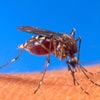pest library - mosquito

he mosquito is a member of the family Culicidae; these insects have a pair of scaled wings, a pair of halteres, a slender body, and long legs. The females of most mosquito species suck blood from other animals. In the English language, the word Mosquito (Span., little fly) dates back to 1583; The word was adopted to replace the term "biting flies" to prevent confusion with the house fly. It is derived from the word musca (Latin fly, cf. Skt maksh) and is related to the Italian moschetta and the French moustique.
The female mosquito (in almost all species) sucks the blood of mammals, including humans. Mosquito bites often swell up hours after happening, causing a red ringed white bump about a centimeter in diameter. This bump can itch for days and over-scratching the bite can cause it to bleed. Mosquito bites can transmit diseases, such as malaria and West Nile Virus, so authorities in many areas take measures to reduce mosquito populations through pesticides or more organic means. An easy way to reduce mosquito populations in a residential area is the removal of standing water (where mosquitoes breed), and the use of repellents, such as DEET.
Mosquitoes and health: In much of the world, mosquitoes are a major public health problem; they are estimated to transmit disease to more than 700 million people annually, and will be responsible for the deaths of about 1 in 17 people currently alive. In the United States and other temperate countries, mosquito bites are mostly just a nuisance.
Mosquito control and integrated mosquito management: There are two kinds of mosquito control: large, organized programs to reduce mosquito populations over a wide area, and actions an individual can take to control mosquitoes with respect to themselves and their own property.
Organized mosquito control programs today draw on the principles of integrated pest management. An integrated mosquito control program typically includes the following measures, all guided by surveillance of mosquito populations and knowledge of the mosquito life cycle:
Pest Library ©2013 Compelling Communications, Inc.
The female mosquito (in almost all species) sucks the blood of mammals, including humans. Mosquito bites often swell up hours after happening, causing a red ringed white bump about a centimeter in diameter. This bump can itch for days and over-scratching the bite can cause it to bleed. Mosquito bites can transmit diseases, such as malaria and West Nile Virus, so authorities in many areas take measures to reduce mosquito populations through pesticides or more organic means. An easy way to reduce mosquito populations in a residential area is the removal of standing water (where mosquitoes breed), and the use of repellents, such as DEET.
Mosquitoes and health: In much of the world, mosquitoes are a major public health problem; they are estimated to transmit disease to more than 700 million people annually, and will be responsible for the deaths of about 1 in 17 people currently alive. In the United States and other temperate countries, mosquito bites are mostly just a nuisance.
Mosquito control and integrated mosquito management: There are two kinds of mosquito control: large, organized programs to reduce mosquito populations over a wide area, and actions an individual can take to control mosquitoes with respect to themselves and their own property.
Organized mosquito control programs today draw on the principles of integrated pest management. An integrated mosquito control program typically includes the following measures, all guided by surveillance of mosquito populations and knowledge of the mosquito life cycle:
- source reduction - the removal of mosquito breeding habitats
- habitat modification - manipulating habitats to reduce breeding
- biocontrol - introducing natural predators of mosquitoes
- larvicide - using pesticides to reduce larval populations
- adulticide - using pesticides to reduce adult populations
Pest Library ©2013 Compelling Communications, Inc.